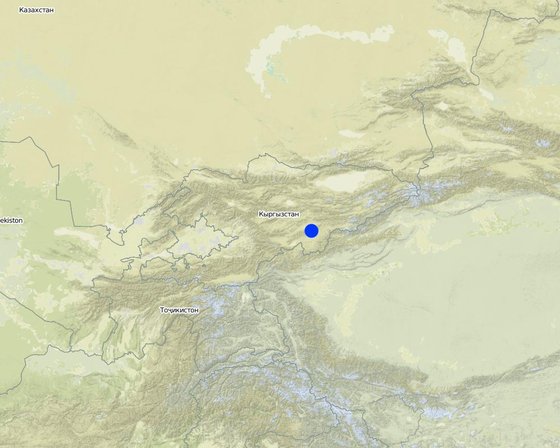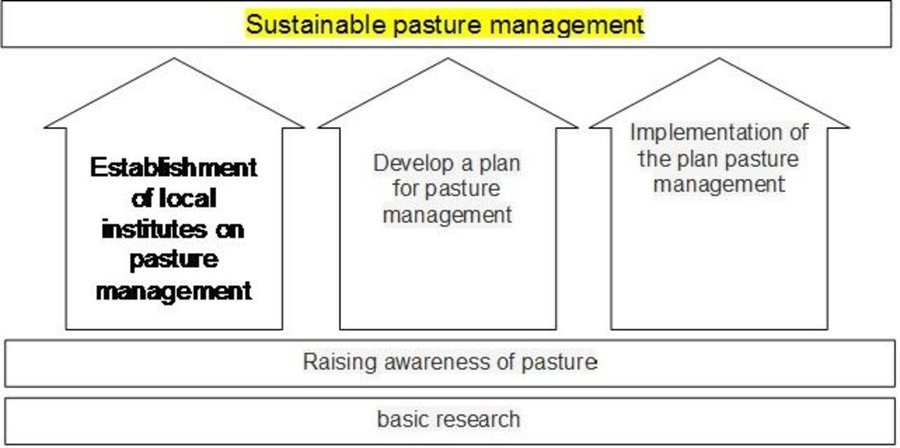



Aims / objectives: Resolution of the degradation and erosion-related problems through sustainable community-based pasture management. The suggested approach is based on the participation of the local population in pasture management by imposing responsibilities on them for the safekeeping and preserving of pastures. A selected part of this approach concerning the development of pasture use plans, was described in a separate approach called “Joint pasture use planning” (WOCAT QAKYR002e)
Methods: Until the adoption of the law “On pastures” in 2009, the responsibilities were shared in the following ways: the oblast state administrations were responsible for the remote pastures; the rayon administrations for intensive pastures; and the village administrations for the near-to-village pastures. After the law’s adoption in 2009, all the authority pertaining to pasture management of all categories was delegated to the bodies of local self-government. In turn, they delegated their pasture management authority to the Pasture Users Associations (PUA), represented by the Pasture Committees. This law became a key factor in the implementation of this approach
Stages of implementation: Implementation of the approach was started by conducting a baseline survey in the pilot territory by the Swiss National Centre of Competence in Research NCCR North-South. 2) Moderators of the public foundation CAMP Ala-Too conducted L4S (learning for sustainability) workshops for pasture users. 3) The outcome of the workshops conducted was the formation of the initiative group to create the PUA. 4) The initiative group dealt with the legalization of this institution, and, as a result, the PUA was established along with its executive body, the Pasture Committee, which develops pasture management plans. 5) Currently, the Pasture Committees monitor the pasture state, the outcomes of which must serve as the basis for the development of a pasture management plan in future
Role of stakeholders: 1. The project “Sustainable pasture management within the river basins of Jergetal and Onarcha”: The joint pasture management approach was implemented within the framework of this project. 2) PF CAMP Ala-Too: executor of the project. 3) Local self-government bodies have delegated the pasture management rights to the PUAs, which allowed them to fully implement the approach. 4) As per the legislation “On pastures”, local communities have the right to establish PUAs with their representative bodies, Pasture Committees. 5) The Pasture Department of the Ministry of Agriculture has ensured support from the Oblast Pasture Department. 6) Experts from the Rural Advisory Service and the Agency for Rural Development and Investment have been trained on separate components of the approach to be disseminated throughout the whole country
Other important information: This approach was implemented by PF CAMP Ala-Too within the framework of the regional program “Sustainable use of natural resources in Central Asia”, implemented by GIZ

Location: Naryn, Naryn, Kyrgyzstan
Initiation date: 2008
Year of termination: 2011
Type of Approach

| What stakeholders / implementing bodies were involved in the Approach? | Specify stakeholders | Describe roles of stakeholders |
| community-based organizations | Pasture users participated in all stages of the approach realization Pasture users and shepherds are traditionally men The difference between participation of men and women is not a consequence of gender discrimination. Historically, it was the man that was responsible for the livestock. However, if they so desire, women are able to participate on an equal basis with the men. Members of the Pasture Committees represent all layers of the population (small, medium and large). Correspondingly, they participate in development of pasture use plan and can stand up for their rights. | Implementation of the approach |
| SLM specialists/ agricultural advisers | The Rural Advisory Services (RAS) took part in dissemination of this approach | |
| NGO | Public Foundation САМР Ala-Too | Elaboration of the approach |
| national government (planners, decision-makers) | Part of the approach was incorporated in the Manual on Designing of Pasture Management Plans for Pasture Committees, approved by the Ministry of Agriculture of the Kyrgyz Republic | |
| international organization |
The approach on sustainable pasture management

Decisions were taken by
Decisions were made based on
Training of trainers and training on this approach was conducted for pasture users from the pilot region by the local advisory services. The approach includes creating awareness; training on pasture monitoring; pasture use planning; calculation of budget for pasture management plan and the cost of pasture tickets.
Within the baseline survey in the pilot territories, which was conducted by the Swiss National Centre for Competence in Research NCCR North-South, the background socio-economic and ecological situations were explored and analysed
Research was carried out both on station and on-farm
Introduction of this approach facilitated the improvement of 250000 ha of pastures in the pilot territory; reduction of the pasture pressure by conflict management between the pasture users.
Poor segments of the population along with others have access to all categories of pastures.
The World Bank “Agricultural Investment Services Project”, component “pasture management”. Within the framework of this project, a manual for Pasture Committees on development of pasture management plans was designed for the use of this approach. All 454 Pasture Committees of the Kyrgyz Republic work according to this manual.
The approach foresees the establishment of Pasture Committees – institutes, which are responsible for pasture management at the local level. The funding mechanism of these institutes is stipulated by legislation of the Kyrgyz Republic and is based on fees paid by the pasture users for livestock grazing. These payments form the budget of the Pasture Committee.